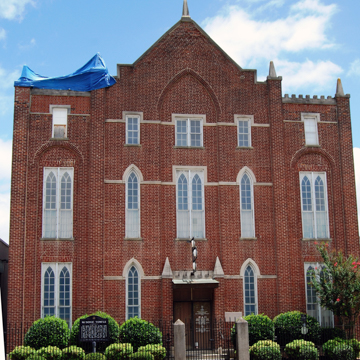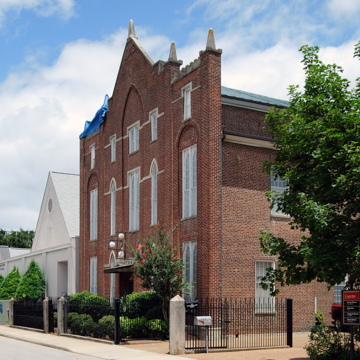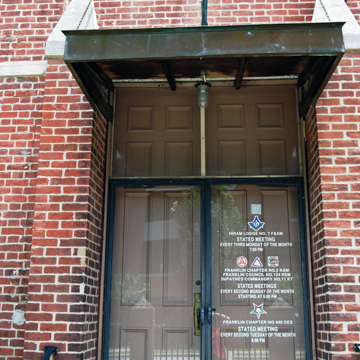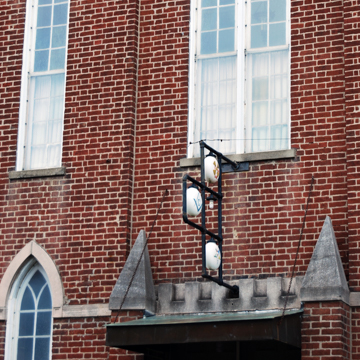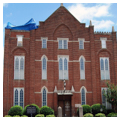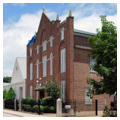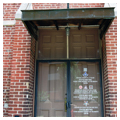You are here
Hiram Masonic Lodge No. 7
Built around 1823, the brick, Gothic Revival Hiram Masonic Lodge No. 7 is situated at the north edge of historic downtown Franklin, the county seat of Williamson County. It is the oldest extant public building in Franklin, and probably the earliest significant Gothic Revival building in Tennessee. One of nine lodges established by the Grand Lodge of North Carolina and Tennessee between 1796 and 1812, the lodge in Franklin was chartered in 1809. It is the oldest continually operating Masonic Lodge in the state and the site of fellowship for generations of Franklin’s most prominent businessmen and civic leaders.
The three-story building is distinguished by the Flemish bond of its facade and numerous traceried Gothic arch windows. While the windows are slightly recessed, the facade is generally flat in appearance, marking it a sort of Federal-style version of the Gothic Revival. We do not know who designed the three-story lodge, but the architect was probably familiar with a print of William Strickland’s Masonic Hall in Philadelphia, built in 1811 and lost to fire in 1819. In Franklin, as in Philadelphia, the main facade is articulated with four tall, pilaster-like projections, each capped with a pyramidal pinnacle. Like the Philadelphia building, the Franklin lodge has Gothic windows with stone hood moldings and Norman crenellations.
The building played an important, if ignominious, role in the nation’s history. In August 1830, three months after President Andrew Jackson signed the Indian Removal Act, he met with Chickasaw Nation representatives at Hiram Masonic Lodge No. 7 to negotiate the Treaty of Franklin. This was the first and only time a president met with an Indian council to negotiate a treaty, which resulted in the removal of the Chickasaw from their homelands, the commencement of the Trail of Tears, and the acceleration of westward expansion by the United States. Occupied by both Confederate and Union soldiers during the Civil War, the building was damaged during the Battle of Franklin, but was later restored. The building still serves as a Masonic lodge.
References
Heritage Foundation of Franklin and Williamson County. National Register Properties, Williamson County, Tennessee.Franklin, TN: Hillsboro Press, 1995.
Levy, Benjamin, “Hiram Masonic Lodge No. 7,” Williamson County, Tennessee. National Historic Landmarks Nomination Form, 1973. National Park Service, U.S., Department of the Interior, Washington DC.
“Indian Removal Act.” Library of Congress Primary Documents in American History. Accessed July 28, 2016. https://www.loc.gov/rr/program/bib/ourdocs/Indian.html.
Patrick, James. Architecture in Tennessee, 1768–1897.Knoxville: University of Tennessee Press, 1981.
Satz, Ronald N. “Chickasaws.” In Tennessee Encyclopedia of History and Culture. Tennessee Historical Society, 2002–2016. Last updated January 1, 2010. https://tennesseeencyclopedia.net/entry.php?rec=247.
“Temple Holds ‘Firsts’.” The Tennessean, July 9, 1978.
“1830–1860 Indian Treaties and the Removal Act of 1830.” US Department of State, Office of the Historian Milestones. Accessed July 28, 2016. https://history.state.gov/milestones/1830-1860/indian-treaties.
Writing Credits
If SAH Archipedia has been useful to you, please consider supporting it.
SAH Archipedia tells the story of the United States through its buildings, landscapes, and cities. This freely available resource empowers the public with authoritative knowledge that deepens their understanding and appreciation of the built environment. But the Society of Architectural Historians, which created SAH Archipedia with University of Virginia Press, needs your support to maintain the high-caliber research, writing, photography, cartography, editing, design, and programming that make SAH Archipedia a trusted online resource available to all who value the history of place, heritage tourism, and learning.














